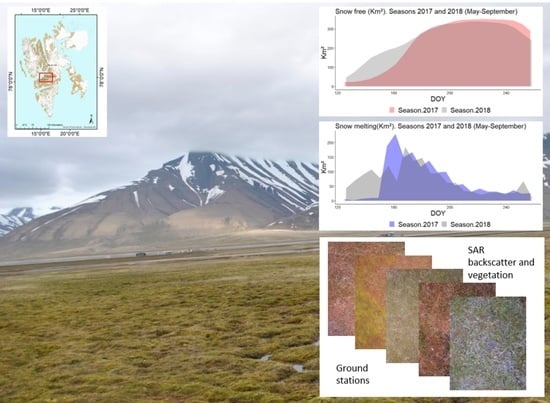Multi-Sensor Analysis of Snow Seasonality and a Preliminary Assessment of SAR Backscatter Sensitivity to Arctic Vegetation: Limits and Capabilities
Abstract
:1. Introduction
- 1.
- to apply a combination of radar and optical satellite data (Sentinel-1 and Sentinel-2) to map the spatial and temporal pattern of wet and dry snow conditions, and its relation to the vegetation growth season;
- 2.
- to understand how polarized radar data (HV- horizontal transmit and vertical received) can contribute to detect the pattern of arctic vegetation growth and soil moisture.
2. Materials and Methods
2.1. Study Area
2.2. Datasets
3. Methodology
3.1. SAR, Optical and Ground Data Processing
3.2. Snow-Melting Detection
3.3. Snow-Free Mapping and Accuracy Assessment
3.4. Ground Sensor Data Analysis
4. Results
4.1. Snow Masks, Inter-Satellite Cross-Comparison and Ground Validation
4.2. Snow Seasonality
4.3. Multi Sensor Analyses and Vegetation
4.4. Discussion
4.5. Conclusions
Author Contributions
Funding
Acknowledgments
Conflicts of Interest
Appendix A
Appendix A.1.



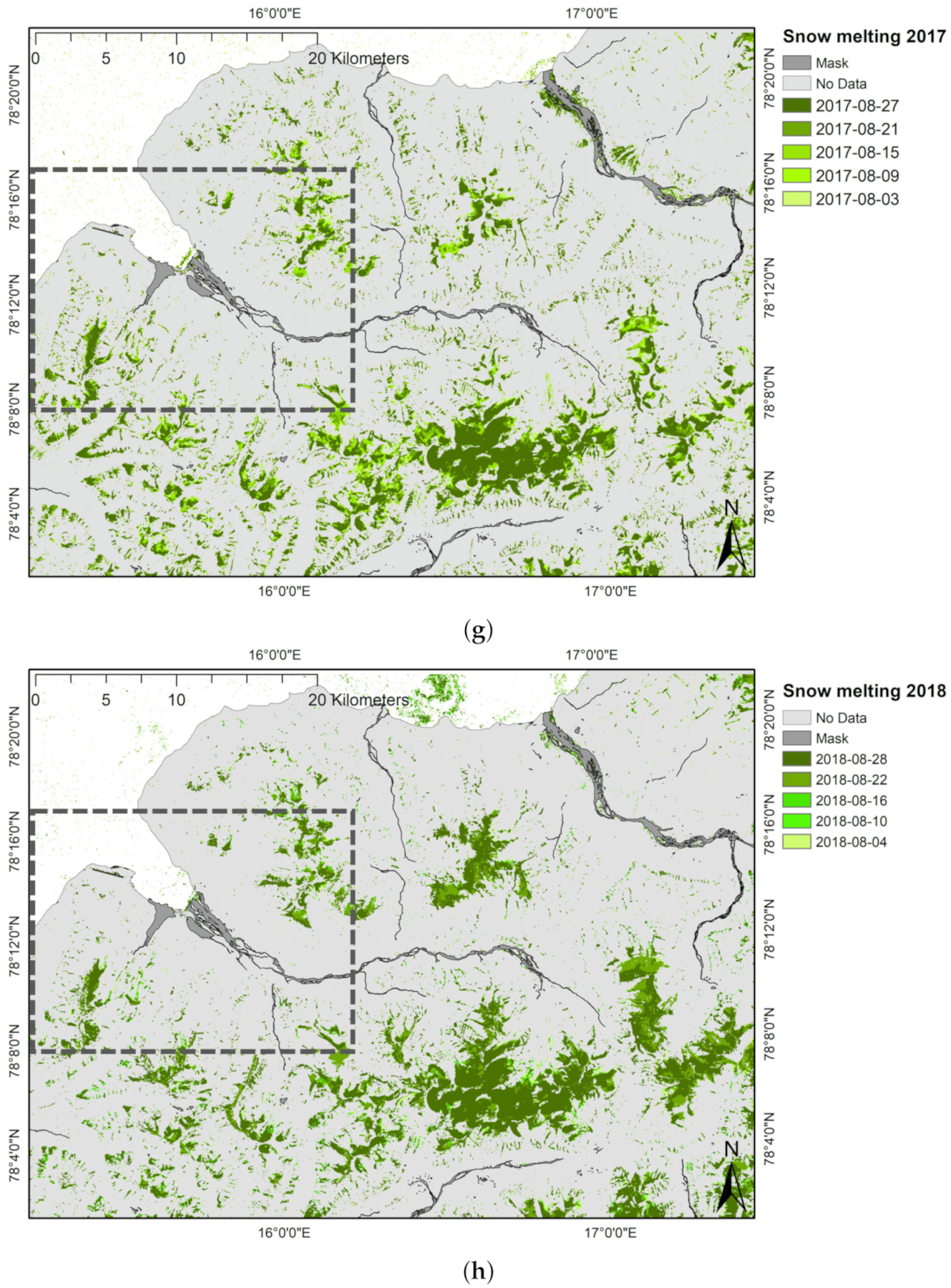

Appendix A.2.
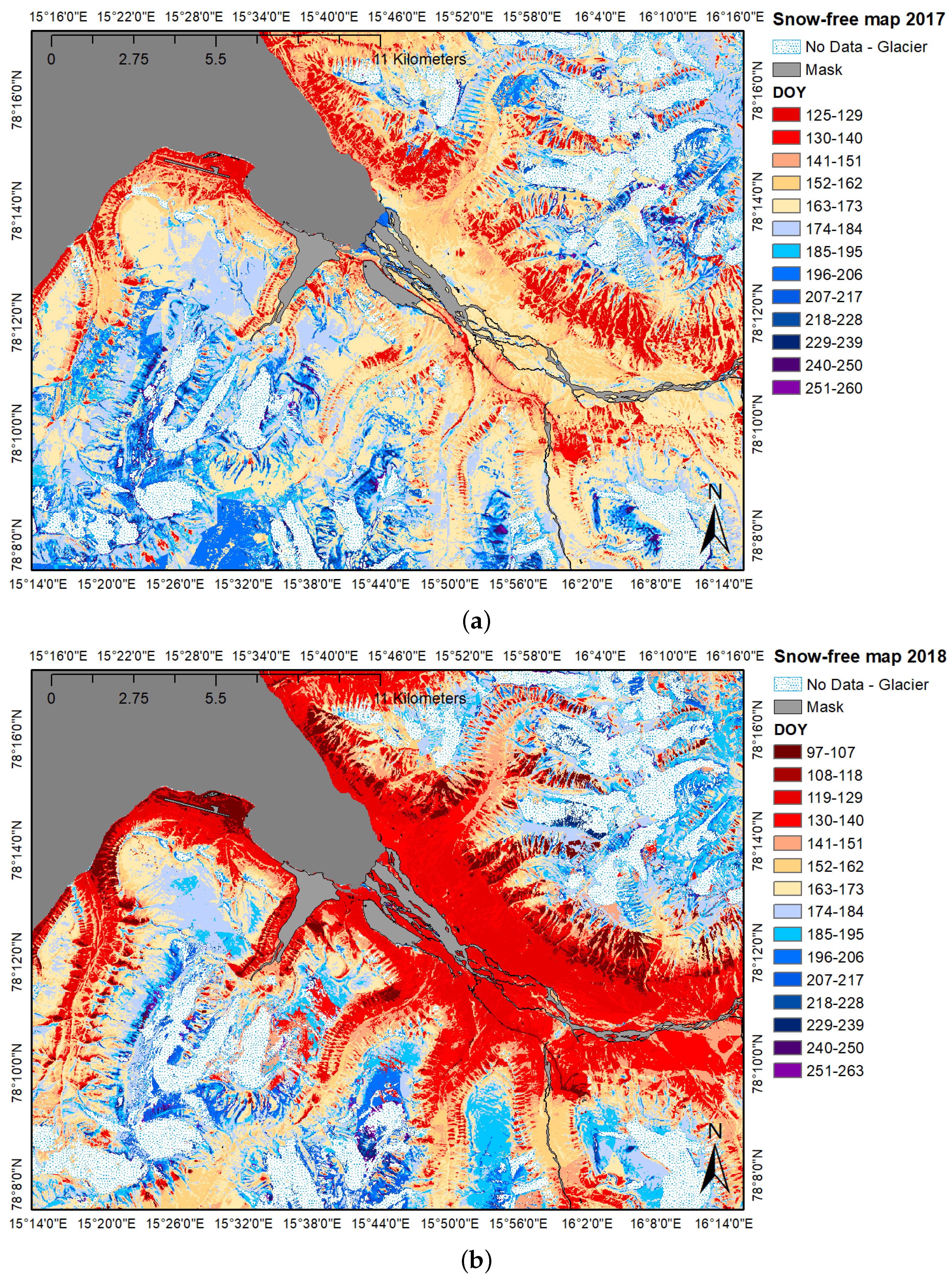
References
- Box, J.E.; Colgan, W.T.; Christensen, T.R.; Schmidt, N.M.; Lund, M.; Parmentier, F.J.W.; Brown, R.; Bhatt, U.S.; Euskirchen, E.S.; Romanovsky, V.E.; et al. Key indicators of Arctic climate change: 1971–2017. Environ. Res. Lett. 2019, 14. [Google Scholar] [CrossRef]
- Gillespie, M.A.K.; Baggesen, N.; Cooper, E.J.H. Arctic flowering phenology and plant–pollinator interactions in response to delayed snow melt and simulated warming. Environ. Res. Lett. 2016, 11, 115006. [Google Scholar] [CrossRef]
- Semenchuk, P.R.; Gillespie, M.A.K.; Rumpf, S.B.; Baggesen, N.; Elberling, B.; Cooper, E.J.H. Arctic plant phenology is determined by snowmelt patterns but duration of phenological periods is fixed: An example of periodicity. Environ. Res. Lett. 2016, 11, 125006. [Google Scholar] [CrossRef] [Green Version]
- Treharne, R.; Bjerke, J.W.; Tømmervik, H.; Stendardi, L.; Phoenix, G.K. Arctic browning: Impacts of extreme climatic events on heathland ecosystem CO2 fluxes. Glob. Chang. Biol. 2019, 25, 489–503. [Google Scholar] [CrossRef] [PubMed] [Green Version]
- Saha, S.K.; Rinke, A.; Dethloff, K.C. Future winter extreme temperature and precipitation events in the Arctic. Geophys. Res. Lett. 2006, 33. [Google Scholar] [CrossRef] [Green Version]
- Hansen, B.B.; Isaksen, K.; Benestad, R.E.; Kohler, J.; Pedersen, Å.; Loe, L.E.; Coulson, S.J.; Larsen, J.O.; Varpe, Ø. Warmer and wetter winters: Characteristics and implications of an extreme weather event in the High Arctic. Environ. Res. Lett. 2014, 9, 114021. [Google Scholar] [CrossRef]
- Vikhamar-Schuler, D.; Isaksen, K.; Haugen, J.E.; Tømmervik, H.; Luks, B.; Schuler, T.V.; Bjerke, J.W. Changes in winter warming events in the Nordic Arctic Region. J. Clim. 2016, 29, 6223–6244. [Google Scholar] [CrossRef]
- Malnes, E.; Karlsen, S.R.; Johansen, B.; Bjerke, J.W.; Tømmervik, H. Snow season variability in a boreal-Arctic transition area monitored by MODIS data. Environ. Res. Lett. 2016, 11, 125005. [Google Scholar] [CrossRef] [Green Version]
- Winther, J.-G.; Bruland, O.; Sand, K.; Gerland, S.; Marechal, D.; Ivanov, B.; Gøowacki, P.; König, M. Snow research in Svalbard—An overview. Polar Res. 2003, 22, 125–144. [Google Scholar] [CrossRef]
- Malnes, E.; Karlsen, S.R.; Johansen, B.; Haarpaintner, J.; Hogda, K.A. Monitoring of the snow coverage and its relation to vegetation and growing seasons on Svalbard using ENVISAT ASAR and TERRA MODIS data. In Proceedings of the ESA Living Planet Symposium, Bergen, Norway, 28 June–2 July 2010; Volume 686, pp. 28.6–28.7. [Google Scholar]
- Vickers, H.; Karlsen, S.R.; Malnes, E. A 20-year MODIS-based snow cover dataset for Svalbard and its link to phenological timing and sea ice variability. Remote Sens. 2020, 12, 1123. [Google Scholar] [CrossRef] [Green Version]
- Hall, D.K.; Riggs, G.A.; Salomonson, V.V. Development of methods for mapping global snow cover using moderate resolution imaging spectroradiometer data. Remote Sens. Environ. 1995, 54, 127–140. [Google Scholar] [CrossRef]
- Salomonson, V.V.; Appel, I. Estimating fractional snow cover from MODIS using the normalized difference snow index. Remote Sens. Environ. 2004, 89, 351–360. [Google Scholar] [CrossRef]
- Shi, J.; Dozier, J. Mapping seasonal snow with SIR-C/X-SAR in mountainous areas. Remote Sens. Environ. 1997, 59, 294–307. [Google Scholar] [CrossRef]
- Nagler, T.; Rott, H. Retrieval of wet snow by means of multitemporal SAR data. IEEE Trans. Geosci. Remote Sens. 2000, 38, 754–765. [Google Scholar] [CrossRef]
- Baghdadi, N.; Gauthier, Y.; Bernier, M. Capability of multitemporal ERS-1 SAR data for wet-snow mapping. Remote Sens. Environ. 1997, 60, 174–186. [Google Scholar] [CrossRef]
- Notarnicola, C.; Ratti, R.; Maddalena, V.; Schellenberger, T.; Ventura, B.; Zebisch, M. Seasonal snow cover mapping in alpine areas through time series of COSMO-skymed images. IEEE Geosci. Remote Sens. Lett. 2012, 10, 716–720. [Google Scholar] [CrossRef]
- Buchelt, S.; Skov, K.; Rasmussen, K.K.; Ullmann, T. Sentinel-1 time series for mapping snow cover depletion and timing of snowmelt in Arctic periglacial environments: Case study from Zackenberg and Kobbefjord, Greenland. Cryosphere 2022, 16, 625–646. [Google Scholar] [CrossRef]
- Hallikainen, M.; Ulaby, F.; Abdelrazik, M. Dielectric properties of snow in the 3 to 37 GHz range. IEEE Trans. Antennas Propag. 1986, 34, 1329–1340. [Google Scholar] [CrossRef]
- Mätzler, C.; Schanda, E. Snow mapping with active microwave sensors. Remote Sens. 1984, 5, 409–422. [Google Scholar] [CrossRef]
- Ulaby, F. Radar response to vegetation. IEEE Trans. Antennas Propag. 1975, 23, 36–45. [Google Scholar] [CrossRef]
- Attema, E.P.W.; Ulaby, F.T. Vegetation modeled as a water cloud. Radio Sci. 1978, 13, 357–364. [Google Scholar] [CrossRef]
- De Bernardis, C.; Vicente-Guijalba, F.; Martinez-Marin, T.; Lopez-Sanchez, J.M. Contribution to real-time estimation of crop phenological states in a dynamical framework based on NDVI time series: Data fusion with SAR and temperature. IEEE J. Sel. Top. Appl. Earth Obs. Remote Sens. 2016, 9, 3512–3523. [Google Scholar] [CrossRef] [Green Version]
- Torres, R.; Snoeij, P.; Geudtner, D.; Bibby, D.; Davidson, M.; Attema, E.; Potin, P.; Rommen, B.; Floury, N.; Brown, M.; et al. GMES Sentinel-1 mission. Remote Sens. Environ. 2012, 120, 9–24. [Google Scholar] [CrossRef]
- Drusch, M.; Del, B.U.; Carlier, S.; Colin, O.; Fernandez, V.; Gascon, F.; Hoersch, B.; Isola, C.; Laberinti, P.; Martimort, P.; et al. Sentinel-2: ESA’s optical high-resolution mission for GMES operational services. Remote Sens. Environ. 2012, 120, 25–36. [Google Scholar] [CrossRef]
- Christiansen, H.H.; Humlum, O.; Eckerstorfer, M. Central Svalbard 2000–2011 meteorological dynamics and periglacial landscape response. Arct. Antarct. Alp. Res. 2013, 45, 6–18. [Google Scholar] [CrossRef] [Green Version]
- Peel, M.C.; Finlayson, B.L.; McMahon, T.A. Updated world map of the Köppen-Geiger climate classification. Hydrol. Earth Syst. Sci. Discuss. 2007, 4, 439–473. [Google Scholar] [CrossRef] [Green Version]
- Elvebakk, A. Tundra diversity and ecological characteristics of Svalbard. Ecosyst. World Polar Alp. Tundra 1997, 347, 347–360. [Google Scholar]
- Elvebakk, A. A vegetation map of Svalbard on the scale 1: 3.5 mill. Phytocoenologia 2005, 35, 951–967. [Google Scholar] [CrossRef]
- Anderson, H.B.; Nilsen, L.; Tømmervik, H.; Karlsen, S.R.; Nagai, S.; Cooper, E.J. Using ordinary digital cameras in place of near-infrared sensors to derive vegetation indices for phenology studies of High Arctic vegetation. Remote Sens. 2016, 8, 847. [Google Scholar] [CrossRef] [Green Version]
- Clerc, S.; Devignot, O.; Pessiot, L.; MPC Team. S2 MPC Level 2A Data Quality Report. In PDGS-MPC-L2ADQR, 39th ed.; ESA Copernicus: Lima, Peru, 2019; pp. 1–18. [Google Scholar]
- Spectral Reflectance Sensor for NDVI. METER Group, Inc. USA. Available online: https://www.ai-nex.co.jp/SRS-N%20Integrators%20Guide.pdf (accessed on 18 September 2019).
- Soil Temperature and Moisture Sensor (5 TM). METER Group, Inc. USA. Available online: http://publications.metergroup.com/Manuals/20424_5TM_Manual_Web.pdf (accessed on 18 September 2019).
- Infrared Radiometer (SI-421). Apogee Instruments, INC.|721 WEST 1800 NORTH, LOGAN, UTAH 84321, USA. Available online: https://www.apogeeinstruments.com/content/SI-400-manual.pdf (accessed on 18 September 2019).
- Larsen, Y.; Engen, G.; Lauknes, T.R.; Malnes, E.; Høgda, K. Arild A generic differential interferometric SAR processing system, with applications to land subsidence and snow-water equivalent retrieval. In Proceedings of the Fringe 2005 Workshop, ESA ESRIN, (ESA SP-610), Frascati, Rome, 28 November–2 December 2005. [Google Scholar]
- Schellenberger, T.; Ventura, B.; Zebisch, M.; Notarnicola, C. Wet snow cover mapping algorithm based on multitemporal COSMO-SkyMed X-band SAR images. IEEE J. Sel. Top. Appl. Earth Obs. Remote Sens. 2012, 5, 1045–1053. [Google Scholar] [CrossRef]
- Hollstein, A.; Segl, K.; Guanter, L.; Brell, M.; Enesco, M. Ready-to-use methods for the detection of clouds, cirrus, snow, shadow, water and clear sky pixels in Sentinel-2 MSI images. Remote Sens. 2016, 8, 666. [Google Scholar] [CrossRef] [Green Version]
- Zupanc, A. Improving Cloud Detection with Machine Learning. Available online: https://medium.com/sentinel-hub/improving-cloud-detection-with-machine-learning-c09dc5d7cf13 (accessed on 20 September 2019).
- Karlsen, S.R.; Elvebakk, A.; Høgda, K.A.; Grydeland, T. Spatial and temporal variability in the onset of the growing season on Svalbard, Arctic Norway—measured by MODIS-NDVI satellite data. Remote Sens. 2014, 6, 8088–8106. [Google Scholar] [CrossRef] [Green Version]
- Karlsen, S.R.; Stendardi, L.; Tømmervik, H.; Nilsen, L.; Arntzen, I.; Cooper, E.J. Time-Series of Cloud-Free Sentinel-2 NDVI Data Used in Mapping the Onset of Growth of Central Spitsbergen, Svalbard. Remote Sens. 2021, 13, 3031. [Google Scholar] [CrossRef]
- Matthew, J.M.; Christopher, S.S.; Kyle, J.; Martha, K.R. Landsat-based snow persistence map for northwest Alaska. Remote Sens. Environ. 2015, 163, 23–31. [Google Scholar] [CrossRef]
- Rignot, E.J.M.; Van, Z.J.J. Change detection techniques for ERS-1 SAR data. IEEE Trans. Geosci. Remote Sens. 1993, 31, 896–906. [Google Scholar] [CrossRef] [Green Version]
- Metsämäki, S.; Vepsäläinen, J.; Pulliainen, J.; Sucksdorff, Y. Improved linear interpolation method for the estimation of snow-covered area from optical data. Remote Sens. Environ. 2002, 82, 64–78. [Google Scholar] [CrossRef]
- Qiu, D.; Shao, Q.; Yang, L. Efficient inference for autoregressive coefficients in the presence of trends. J. Multivar. Anal. 2013, 114, 40–53. [Google Scholar] [CrossRef]
- Budescu, D.V. Dominance analysis: A new approach to the problem of relative importance of predictors in multiple regression. Psychol. Bull. 1993, 114, 542–551. [Google Scholar] [CrossRef]
- Floricioiu, D.; Rott, H. Seasonal and short-term variability of multifrequency, polarimetric radar backscatter of alpine terrain from SIR-C/X-SAR and AIRSAR data. IEEE Trans. Geosci. Remote Sens. 2001, 39, 2634–2648. [Google Scholar] [CrossRef]
- Ferrazzoli, P.; Paloscia, S.; Pampaloni, P.; Schiavon, G.; Sigismondi, S.; Solimini, D. The potential of multifrequency polarimetric SAR in assessing agricultural and arboreous biomass. IEEE Trans. Geosci. Remote Sens. 1997, 35, 5–17. [Google Scholar] [CrossRef]
- Macelloni, G.; Paloscia, S.; Pampaloni, P.; Marliani, F.; Gai, M. The relationship between the backscattering coefficient and the biomass of narrow and broad leaf crops. IEEE Trans. Geosci. Remote Sens. 2001, 39, 873–884. [Google Scholar] [CrossRef]
- McNairn, H.; Brisco, B. The application of C-band polarimetric SAR for agriculture: A review. Can. J. Remote Sens. 2004, 30, 525–542. [Google Scholar] [CrossRef]
- Scholander, P.F. Vascular Plants from Northern Svalbard: With Remarks on the Vegetation in North-East Land. 1934. Available online: http://hdl.handle.net/11250/173806 (accessed on 23 September 2019).
- Available online: https://svalbardflora.no/ (accessed on 30 September 2019).
- Eckerstorfer, M.; Malnes, E.; Christiansen, H.H. Freeze/thaw conditions at periglacial landforms in Kapp Linné, Svalbard, investigated using field observations, in situ, and radar satellite monitoring. Geomorphology 2017, 293, 433–447. [Google Scholar] [CrossRef]
- Bergstedt, H.; Zwieback, S.; Bartsch, A.; Leibman, M. Dependence of C-band backscatter on ground temperature, air temperature and snow depth in arctic permafrost regions. Remote Sens. 2018, 10, 142. [Google Scholar] [CrossRef] [Green Version]
- Baghdadi, N.; Bazzi, H.; El Hajj, M.; Zribi, M. Detection of frozen soil using Sentinel-1 SAR data. Remote Sens. 2018, 10, 1182. [Google Scholar] [CrossRef] [Green Version]
- Rydén, B.E.; Kostov, L. Thawing and freezing in tundra soils. Ecol. Bull. 1980, 30, 251–281. [Google Scholar] [CrossRef]
- Le Moullec, M.; Pedersen, Å.Ø.; Stien, A.; Rosvold, J.; Hansen, B.B. A century of conservation: The ongoing recovery of Svalbard reindeer. J. Wildl. Manag. 2019, 83, 1676–1686. [Google Scholar] [CrossRef]
- Speed, J.D.M.; Woodin, S.J.; Tømmervik, H.; Van der Wal, R. Extrapolating herbivore-induced carbon loss across an arctic landscape. Polar Biol. 2010, 33, 789–797. [Google Scholar] [CrossRef]
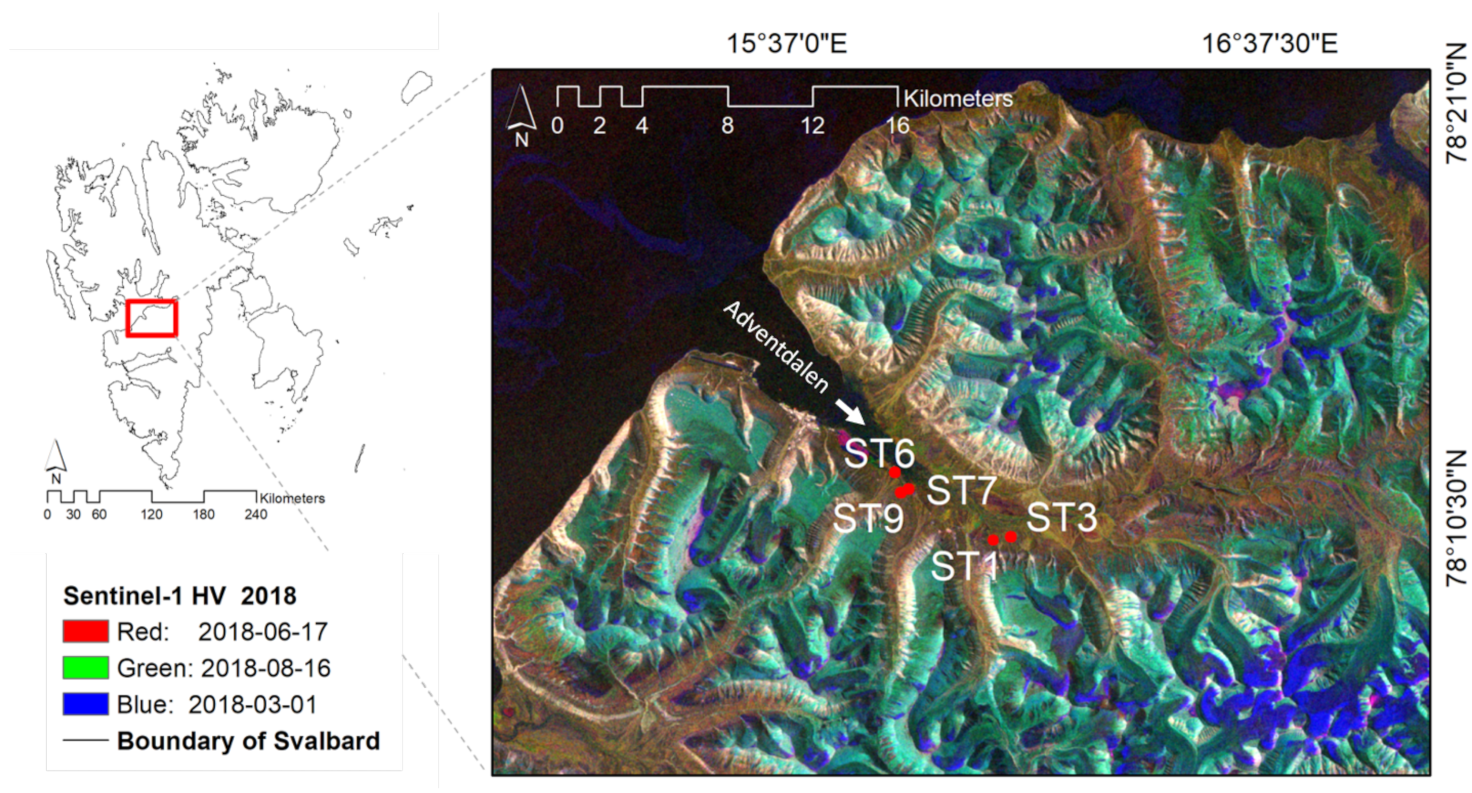


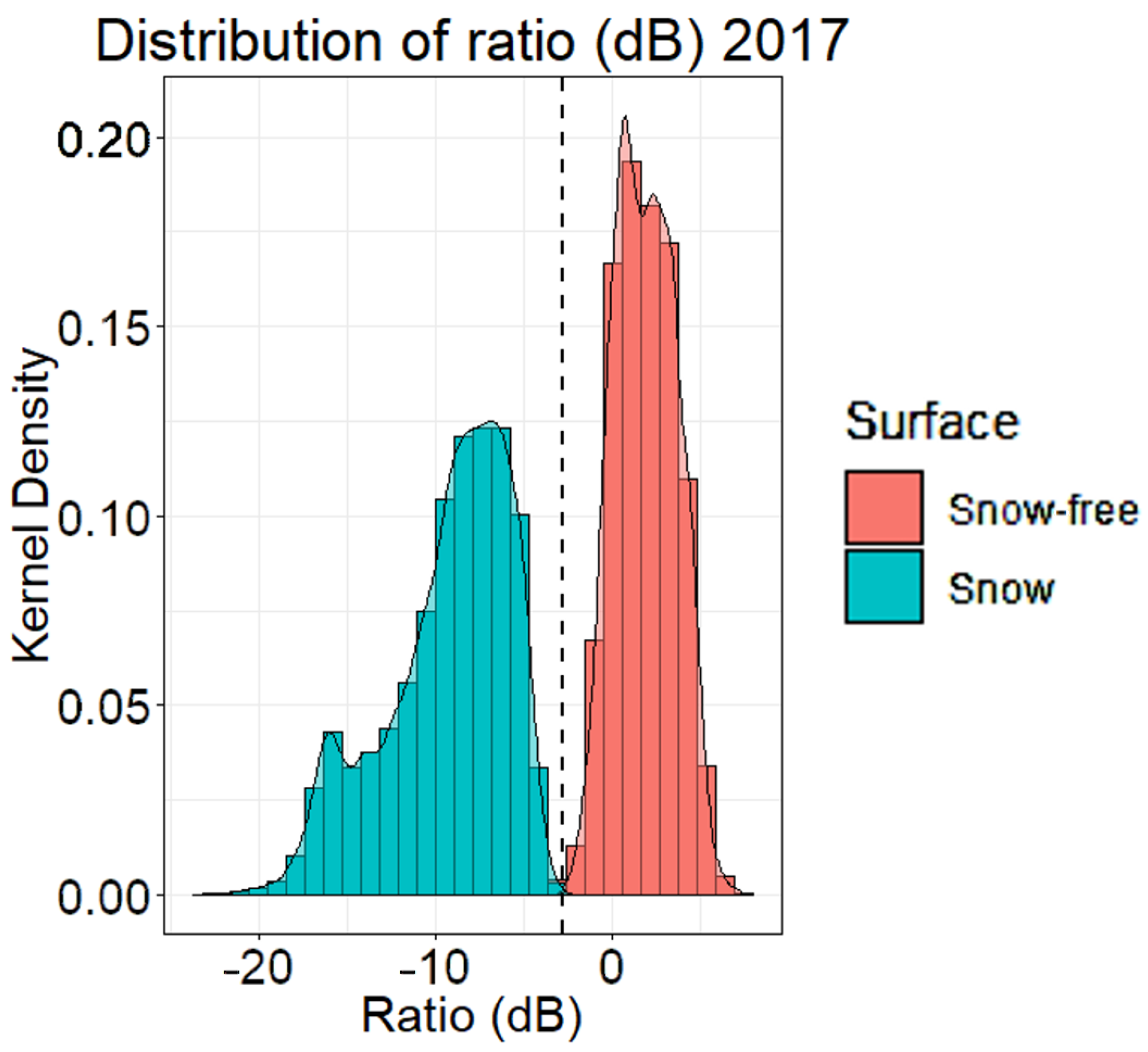
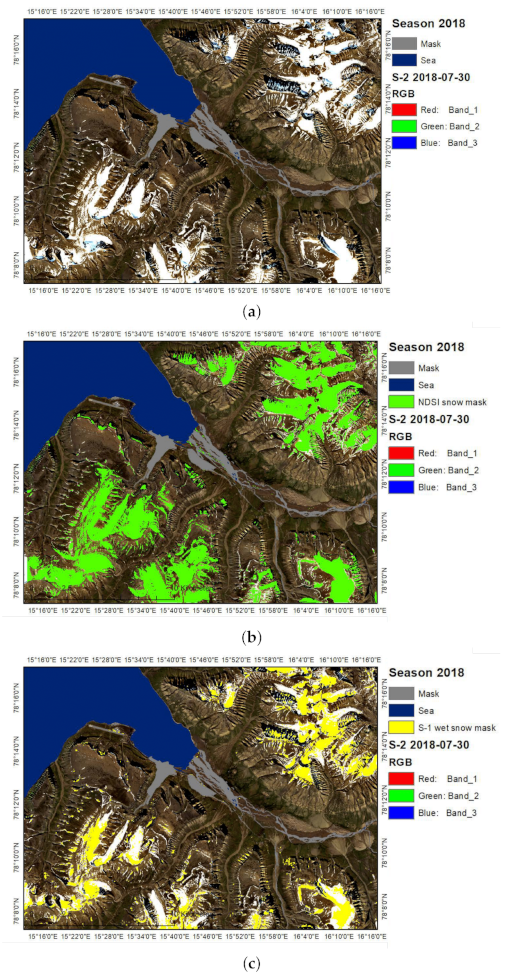


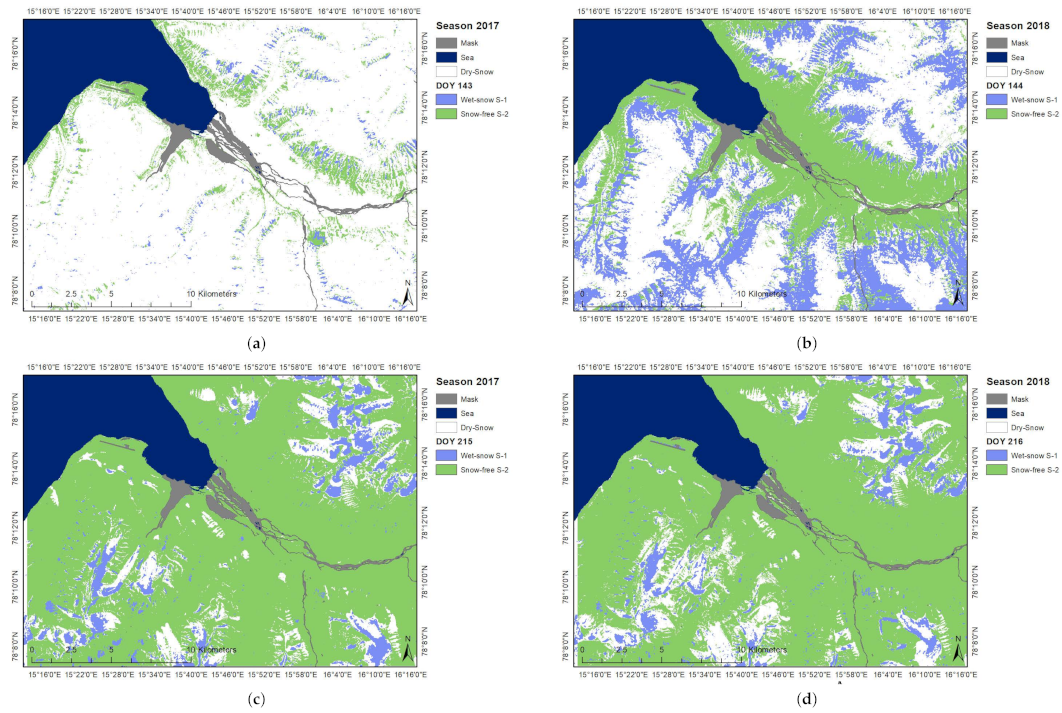

| Station | UTM X | UTM Y | Vegetation and Site Description | Sensors |
|---|---|---|---|---|
| ST1 | 523620 | 8677555 | Moist moss tundra with Alopecurus ovatus, Bistorta vivipara and Salix polaris. Depressions with Equisetum arvense, patches of Saxifraga hirculus, and scattered Dupontia fisheri and Eriophorum scheuchzeri. Vegetation cover: 100% | NDVI sensor, soil temperature/moisture, Infrared radiometer, PhenoCams |
| ST3 | 524461 | 8677707 | Mosaic of the shrub Dryas octopetala, and graminoids, e.g., Luzula confusa, Poa pratensis alpigena and Alopecurus ovatus. Lots of Salix polaris and Bistorta vivipara on moist to wet moss tundra dominated by silty sand. Small landscape feature dominated by soil frost polygon with little vegetation in the center. Vegetation cover: 90–100% | NDVI sensor, soil temperature/moisture, Infrared radiometer, PhenoCams |
| ST6 | 519008 | 8680756 | Grass dominated sandy sediment plain. Festuca rubra, Poa pratensis ssp alpigena, and Alopecurus ovatus.Thin organic layer, with lots of Salix polaris in between the grasses. Vegetation cover: 80–100% | NDVI sensor, soil temperature/moisture, PhenoCams |
| ST7 | 519655 | 8679964 | Wetland vegetation on flat silty and sandy substrate, dominated by large polygon soil patterns. Puccinellia phryganodes, Dupontia fisheri and Eriophorum scheuchzeri in the interior part of polygons, while Ranunculus pygmeaus and bryophytes such as Scorpidium cossonii and Scorpidium revolvens dominate the wettest part in polygon cracks. Vegetation cover: 100% | NDVI sensor, soil temperature/moisture, PhenoCams |
| ST9 | 519280 | 8679794 | Heath dominated by Luzula confusa. Other species present are Salix polaris, Poa pratensis alpigena, Cerastium arcticum and bryophytes such as Sanionia uncinata and Tomentypnum nitens. Some cryoturbation and silty soil. Vegetation cover: 70–100% | NDVI sensor, soil temperature/moisture, PhenoCams |
| Image Date | Snow Depth (cm) | Air Temperature Mean (C) | Air Temperature Max (C) | Air Temperature Min (C) | Precipitation (mm) |
|---|---|---|---|---|---|
| 6 March 2017 | 9 | −11.8 | −7.2 | −13.3 | - |
| 12 March 2017 | 9 | −16.9 | −14.9 | −21.5 | 0.4 |
| 24 March 2017 | 12 | −11.2 | −8.9 | −12.5 | 1.6 |
| 10 July 2017 | - | 7.4 | 8.7 | 5.7 | - |
| 22 July 2017 | - | 8.3 | 10.9 | 5.9 | - |
| 3 August 2017 | - | 8.1 | 10.6 | 7.4 | - |
| 17 February 2018 | 21 | −16.3 | −10.4 | −22.6 | - |
| 7 March 2018 | 13 | −16 | −13.9 | −16.7 | - |
| 13 March 2018 | 14 | −18.3 | −14.8 | −20.4 | - |
| Station | Ground Sensors | Snow Mask |
|---|---|---|
| SN99870-2017 | 150 (30 May) | 142 (22 May) |
| ST1-2017 | 151 (31 May) | 154 (3 June) |
| ST3-2017 | 150 (30 May) | 146 (26 May) |
| ST6-2017 | 141 (21 May) | 144 (24 May) |
| ST7-2017 | 152 (1 June) | 147 (27 May) |
| ST9-2017 | 154 (3 June) | 166 (15 June) |
| SN99870-2018 | 128 (8 May) | 124 (4 May) |
| Time Series | Station | Pearson 2017 | p-Value 2017 | Pearson 2018 | p-Value 2018 |
|---|---|---|---|---|---|
| S1 HV ∼ NDVI | ST1 | 0.36 | 0.000 | 0.52 | 0.000 |
| ST3 | 0.09 | 0.379 | 0.23 | 0.014 | |
| ST6 | 0.64 | 0.000 | 0.69 | 0.000 | |
| ST7 | 0.45 | 0.000 | 0.56 | 0.000 | |
| ST9 | 0.53 | 0.000 | 0.14 | 0.147 | |
| S1 HV ∼ SWC | ST1 | 0.17 | 0.094 | 0.61 | 0.000 |
| ST3 | 0.81 | 0.000 | 0.71 | 0.000 | |
| ST6 | 0.42 | 0.000 | 0.53 | 0.000 | |
| ST7 | 0.000 | 0.000 | |||
| ST9 | 0.44 | 0.000 | 0.65 | 0.000 | |
| S1 HV ∼ Temp | ST1 | 0.38 | 0.000 | 0.19 | 0.047 |
| ST3 | 0.30 | 0.002 | 0.19 | 0.043 | |
| ST6 | 0.79 | 0.000 | 0.32 | 0.000 | |
| ST7 | 0.77 | 0.000 | 0.50 | 0.000 | |
| ST9 | 0.68 | 0.000 | 0.195 |
| Station | 2017 NDVI % | 2017 SWC% | 2018 NDVI% | 2018 SWC% |
|---|---|---|---|---|
| ST1 | 87 | 13 | 42 | 58 |
| ST3 | 1 | 99 | 8 | 92 |
| ST6 | 71 | 29 | 64 | 36 |
| ST7 | 64 | 36 | 74 | 26 |
| ST9 | 59 | 41 | 2 | 98 |
Publisher’s Note: MDPI stays neutral with regard to jurisdictional claims in published maps and institutional affiliations. |
© 2022 by the authors. Licensee MDPI, Basel, Switzerland. This article is an open access article distributed under the terms and conditions of the Creative Commons Attribution (CC BY) license (https://creativecommons.org/licenses/by/4.0/).
Share and Cite
Stendardi, L.; Karlsen, S.R.; Malnes, E.; Nilsen, L.; Tømmervik, H.; Cooper, E.J.; Notarnicola, C. Multi-Sensor Analysis of Snow Seasonality and a Preliminary Assessment of SAR Backscatter Sensitivity to Arctic Vegetation: Limits and Capabilities. Remote Sens. 2022, 14, 1866. https://doi.org/10.3390/rs14081866
Stendardi L, Karlsen SR, Malnes E, Nilsen L, Tømmervik H, Cooper EJ, Notarnicola C. Multi-Sensor Analysis of Snow Seasonality and a Preliminary Assessment of SAR Backscatter Sensitivity to Arctic Vegetation: Limits and Capabilities. Remote Sensing. 2022; 14(8):1866. https://doi.org/10.3390/rs14081866
Chicago/Turabian StyleStendardi, Laura, Stein Rune Karlsen, Eirik Malnes, Lennart Nilsen, Hans Tømmervik, Elisabeth J. Cooper, and Claudia Notarnicola. 2022. "Multi-Sensor Analysis of Snow Seasonality and a Preliminary Assessment of SAR Backscatter Sensitivity to Arctic Vegetation: Limits and Capabilities" Remote Sensing 14, no. 8: 1866. https://doi.org/10.3390/rs14081866





